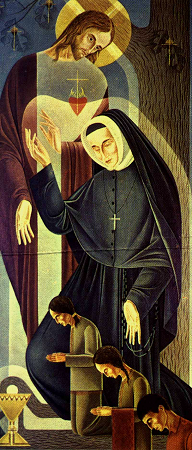
Quakahkanumad (Woman Who Prays Always) was the name Philippine Duchesne was given by the Potawatomi when she lived in Sugar Creek for a short time during her "grandmother" years. It is an honor for a non-indigenous person to be named by an indigenous tribe, and in the remaining ten years of her life after she left Sugar Creek, Philippine continued to live up to her Potawatomi name. In fact, the legacy of Philippine's witness to contemplation continues to be attractive in today's frantically-paced world. For her, God was the Centre who nourished and supported all life, and a Presence in whom she trusted.
Along with contemplation, another aspect of Philippine's life calls us today. That is her capacity to go to new frontiers. As a middle-aged woman, Philippine, along with her 4 companions*, braved a journey by sea from their familiar homeland to a frontier new to them. They discovered, as we do in our lives, that to reach for new frontiers means more than geographic relocation. Philippine's writings tell us that she never stopped responding to the call to reach for new frontiers that she also perceived within her very being.
During her life, Philippine faced many challenges that called her beyond the places where she imagined life might take her. As a young woman, despite her father's opposition, she went beyond the limits of her family home to enter Grenoble's Visitation convent, Ste. Marie d'en Haut. As a middle-aged woman, and through the political context in which she lived, God called her beyond the doors of cloister and her first congregation. As a Religious of the Sacred Heart, Philippine reached for frontiers beyond her city and country of birth. But, upon arriving, new challenges and other kinds of frontiers beckoned. It was in America where Philippine found herself standing at the threshold that joins and distinguishes capacity and vulnerability. This is the place of creativity. By reaching for new frontiers Philippine opened herself to the Sacred Heart of creativity of which she and now we are part.
At General Chapter 2016, a large poster-size copy of Mother Margaret Mary Nealis's painting of Philippine** was prominently placed as part of the prayer decor in the Chapter room. On one occasion at the beginning of the Chapter, capitulants were invited to enter into silent reflection about what they might need to let-go in order to reach beyond the familiar and enter into the new frontier to which they had come, i.e. the Chapter of the whole. One by one, in silence each capitulant placed at an altar beneath the poster of Philippine a symbol of her prayer. This gesture called capitulants to trust the emerging future, and like Philippine to reach beyond borders fixed by personal agendas, beyond provincial and regional boundaries, and to choose to come together into a place of creative vulnerability with God as the Centre.
Did Philippine enjoy amazement at her capacity to be vulnerable as she continued to reach far beyond the familiar, not only geographically, but also within herself? Do we allow God to amaze us in this way?
Reflection by Sheila Smith, RSCJ
* The names of Philippine's 4 companions are: Eugénie Audé, Octavia Berthold, Marguerite Manteau, Catherine Lamarre.
**The original is in Halifax, NS, Canada.



